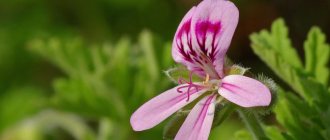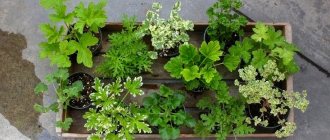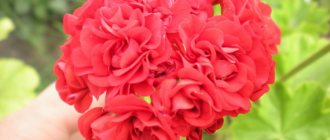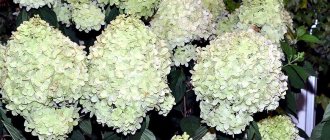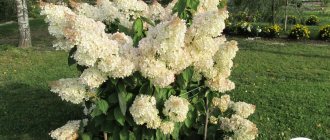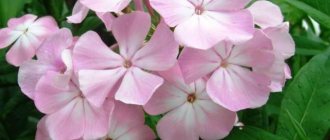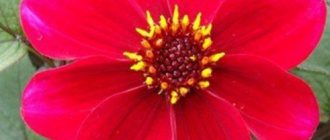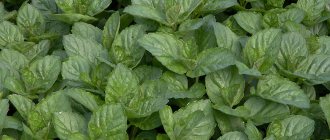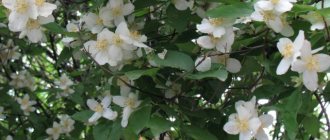Geranium, or pelargonium, is a large genus of the Geraniaceae family. More than 400 varieties are known, among which there are herbaceous and semi-shrub forms. It is found almost everywhere in the wild and has been grown as an ornamental crop since the 17th century. Today, several thousand varieties have been bred, including both indoor and garden plants. In the article you will find the most beautiful types of geraniums.
What you need to know about geranium?
Basic requirements for long flowering geraniums:
- It can bloom all summer and autumn until winter if the flowerpot with it is placed on a window on the south side
- Loves direct sunlight
- In summer, geranium grows well and blooms at room temperature, in winter it has a dormant period, at this time we water it rarely and keep it in a cool place with a temperature of about 15 degrees Celsius
- In summer, water geraniums abundantly and often, as soon as the soil dries on top.
- We feed the flower once every 2 weeks with complex mineral fertilizer for flowering, starting from the end of March and ending in mid-November
- In autumn we prune the plant, leaving shoots with 6-7 leaves
- For abundant flowering in spring and summer, pinch out young shoots after 4-5 leaves have grown
- Geranium can reproduce by shoots and seeds
Attention: You can prepare geraniums for flowering when there is a lot of sunlight, at least 4-6 hours a day.
Reproduction
Indoor geranium is propagated by:
- By seeds, but this method does not always guarantee the repetition of the maternal properties of hybrids.
- By cuttings.
Seeds are sown in soil prepared from equal parts of peat, sand and a double portion of turf soil. The main part of the soil mixture is placed in a container, at the bottom of which there is a drainage layer. Sow the seeds over the surface at a distance of 2 cm from each other, then cover the remaining soil with a thin layer. Moisten with a spray bottle.
Cover the dishes with glass or film and keep them warm (temperature about 20°C). Every day they ventilate by removing the glass and shaking off any drops from it. When the first seeds germinate, remove the cover and lower the temperature (you can place it on the windowsill, where it is lower than in the rest of the room).
For the next 2 months, the seedlings are watered, waiting until they have 2 true leaves. Plants are planted in separate small-diameter pots. To get a beautifully shaped plant, pinch the top after the 6th leaf. When sowing seeds collected with your own hands, they are first scarified. To do this, you can grind them with sandpaper.
Geraniums can be propagated by cuttings almost all year round, but in the spring roots are formed more actively.
They take a cutting and leave it in the air for several hours for it to take root. Planted in a container with loose soil or coarse sand. They don't cover. When the cutting takes root, it can be transplanted into another pot.
Most often, cuttings are rooted in a different way. They tear off the lower leaves, place the cutting in a glass of water and wait for roots to form. Then they are planted in a pot.
The soil for growing indoor geraniums is not very fertile. Otherwise, the plant will have many leaves but few flowers. The pot for geraniums should have enough holes to drain excess moisture. A layer of drainage is placed on the bottom of the dish: expanded clay, pebbles, polystyrene foam.
Water as the soil dries out. In winter, in a cool room, watering is carried out a couple of times a month. If the plant is in a warm room, moisten it more often. Plants that were planted in open ground are hidden indoors at the beginning of autumn. They do not tolerate transplantation well. The root system is not able to hold a large amount of soil, so the roots are exposed.
To make geranium easier to transplant, the branches are pruned, limiting their height.
Cut tops can be used for propagation. For the winter, leave a stem on which no more than 7 leaves grow. Remove shoots growing from leaf axils. Leave those that grow from the root. Break off shoots after every 5 leaves. Do not prune geraniums in December and early January. Anti-aging pruning is carried out, leaving 5 buds on the shoot.
Flowering geranium
Geranium bordered or zoned
This variety of geranium is the most popular in the world. The plant got its name because in the middle of its leaves there is a peculiar border of brownish color. Flowers are usually two-colored and can be of the following forms:
- With 5 petals - simple
- With 6-8 petals - semi-double
- If a flower has 8 petals or more it is called double
If zonal geranium is not pinched, it can grow up to 1 m. A special feature of zonal geranium is its round inflorescences, usually protruding above the leaves.
Note. Only zonal geranium loves very bright light; other types of geranium can grow in partial shade.
Geranium zonal terry
Geranium in the form of roses
The double flowers of this geranium look like small roses. There are up to 20 of them in one inflorescence. The petals are one-color or two colors, their outer side is lighter.
Geranium in the form of roses
Geranium in the form of tulips
The flowers (1.5 cm in diameter) of this species resemble tulips that have not yet bloomed. They remain half-closed until the end of flowering. There are up to 40 flowers in one inflorescence. The flowers are pink or red, sometimes white, but rarely.
Geranium in the form of unopened tulips
Geranium unique
Geranium has strongly dissected leaves that have a faint odor. Can grow 1 m or more. Stems are woody. They bear small red flowers, less often pink or white, with dark veins or spots on the petals, like royal geraniums. The petals become lighter towards the middle.
Geranium unique
Geranium angel
This geranium grows in bushes up to 35 cm, no more. The flowers are small, usually two-colored, like pansies. The upper petals on the flower are larger than the lower ones. Geranium comes in a wide variety of shades.
Angel geranium is unpretentious and can grow in both sunny and shaded places. Where there is little light, a pot of geranium is hung and the flower is grown hanging down. And if there is a lot of sun, then the geranium bush grows upward and blooms profusely.
Attention. Geraniums of the “angel” and “royal” varieties are afraid of small white moths - whiteflies that infect them.
Angel Geranium
Royal Geranium
Geranium was called royal because of its beautiful large flowers (5-7 cm in diameter). The flowers are usually multicolored and come in the following colors:
- Darker or lighter in the middle
- Speckled
- Spotted or streaked
Geranium petals overlap each other like a fan.
The edges of the petals are:
- Simple
- Wavy
- Corrugated
The bushes are small in height - 30-60 cm. The leaves have serrations and are odorless. Royal geranium blooms less than other geraniums - 3-4 months. It is also more capricious - it grows only as an indoor flower, but dies in the open air.
Reproduction
Geranium is grown equally successfully both from cuttings and from seeds. Proper drainage and fertilization of the soil is the key to success. This is especially important if the flowers grow in pots. Of course, every weed is immediately removed, even from the pot.
I would like to dwell on the issue of geranium propagation. It can be done in two ways:
- Seed, not very popular among gardeners. However, if you want to breed varieties for those who like to experiment, it is most correct;
- Cuttings, which, in turn, are of two types.
I never thought about the names of flowers, of course, until the time when geraniums became my hobby. I know that there are more than two hundred species of these beautiful plants in the world. At home I grow several varieties - Angel, Terry, Pink. I do various experiments with these plants; they have taken root well in my house and garden.
Read also: Shield plant: planting and care, types of fern and varieties
You shouldn’t have many varieties; it’s better to engage in breeding, create your own varieties, and provide yourself with high-quality seed material. To this I would like to add that geranium seeds are not difficult to sell if you really seriously devote yourself to such a hobby.
When I began to seriously engage in floriculture, I asked what benefits and harm my favorite plant could bring. I was prompted to do this by caring for my little son.
Beautiful large-flowered geranium, red, pink or purple, after some time of inhaling its aroma, will relieve headaches. If you roll the leaves into tubes and put them in your ears, the effect will increase significantly. Bright red pelargonium is most effective.
Video: Royal geranium of unusual colors
Geranium variegated
Geranium is valued for its beautiful leaves:
- White or brownish spots on a green leaf
- On a green leaf there is a border of a different color
- The leaf has veins of a different color
- Round or openwork
- Tricolor
Geranium of this variety blooms very rarely, and some varieties do not bloom at all.
Attention. To preserve the decorative appearance of the leaves of variegated geraniums, a lot of sun is required in summer, and in winter you will have to additionally illuminate the place with flowers.
Geranium variegated
Geranium cactus
Cactus geranium flowers have elongated, sometimes needle-shaped or curled petals. They can be one color or several. This type of geranium is rare.
Geranium cactus
Geranium ivy-leaved
The leaf shape of this geranium is similar to ivy leaves. Just like ivy, ivy-leaved geranium falls with its leaves and flowers downwards. Can grow up to 1 m in length. The leaves are smooth, glossy, monochromatic, sometimes variegated, looking like artificial flowers. Geranium flowers are up to 5 cm in diameter, with 5 or more petals.
Geranium ivy-leaved
Geranium dwarf
The height of geranium is 12-30 cm. It blooms profusely. There is no need to pinch the shoots; the geranium itself forms a neat bush.
Geranium dwarf
Plant care
The flower does not require special conditions for growing, but you need to pay attention to the following points: regular watering, good lighting and air temperature.
I live in a private house and in winter I keep pots of flowers in the house. In the spring, I plant young plants in flower beds, in the front garden, “potted” plants intended for sale, and take them outside. When there is a danger of frost, I cover the plants with film at night.
Varieties of fragrant geraniums
There are now up to 150 varieties of fragrant geranium. Geranium leaves have the following odors:
- Fruits (apples, peaches)
- Tropical fruits (lemon, pineapple, orange)
- Berries (strawberries, wild strawberries - Lady Scarborough variety)
- Flowers (roses, lavender, lily of the valley, wormwood)
- Spices (nutmeg, ginger, cinnamon)
- Candy (caramel)
- chocolate
- Coconut (Grossularioides variety)
- Mint
- Evergreens (pine, cedar, juniper)
- Almond
- Coca-Cola (Dorcas Brigham Lime variety)
- Menthol (Dark Lady variety)
- Balsam
- Men's perfume with a hint of tobacco (Brilliantine variety)
For fragrant geraniums, the main thing is the leaves. They are used as a natural flavor for tea, cosmetics and perfumes. Its flowers are usually inconspicuous, and some varieties bloom very rarely.
Use of the flower
Geranium is used for landscaping an apartment. But in the spring, when the threat of return frosts has passed, it is better to plant it in a flowerbed. All summer it will delight with lush flowering.
Read also: Peony evasive (Maryin root): botanical description and medical use
Geranium leaves are used in salads or for baking. Used as a seasoning. This largely depends on the variety of geranium and the personal preferences of the owner. Geranium leaves are used to scent clothes in closets.
Video: Fragrant pelargonium: varieties, varieties, aromas
Most fragrant or most fragrant geranium
The round, slightly dissected leaves of this plant have an apple scent. It grows as a small spreading bush.
Geranium is the most fragrant
Geranium, scented or aromatic
The greyish-green, heavily lobed leaves of the plant have a rose scent along with a faint aroma of mint. The plant itself is branched, grows up to 30-60 cm in height, with bright pink flowers.
In addition to the main species, there are also subspecies that are classified as aromatic geranium:
- Geranium with leaves that smell strongly of mint and camphor
- Geranium with leaves, with a lighter border, the smell of eucalyptus, blooms with lilac-pink flowers
Geranium aromatica
Geranium capitata
Heart-shaped leaves, pubescent, strongly dissected, with a rich rose scent. The plant grows up to 60 cm in height. The flowers are small lilac-pink, burgundy at the base.
Geranium capitata
Geranium pink
This geranium can grow one and a half meters in height. It smells like roses with the addition of a subtle lemon scent. It grows like a shrub and blooms with pink flowers. Its leaves are strongly dissected into narrow strips.
In addition, rose geranium includes the following subspecies of geranium:
- With palmately dissected leaves, this geranium is also called "Crow's feet", with brighter colors than the main type of rose geranium.
- With even more rugged leaves than the main rose geranium and lilac-pink flowers
Geranium pink "Crow's feet"
Geranium rough
The leaves of rough geranium look very tough, but it destroys viruses better than all fragrant geraniums.
Geranium rough
Geranium curly
The leaves of curly geranium are small, round, dissected, with a golden edge, and have a citrus scent. The flowers are light pink, with burgundy lines on the petals at the base.
Attention. Curly geranium contains a lot of vitamin C, as well as substances such as apigenin and chrysin, which suppress the growth of cancerous tumors. Its leaves are brewed as tea and added to soups, desserts and baked goods.
Geranium curly
Geranium felt
The plant grows small, up to 30 cm tall, new shoots droop slightly. The leaves are medium-sized and large, round, half dissected into 3-5 lobes, pubescent, with a mint scent. The flowers are small, slightly pink with purple pistils, with purple spots on the petals the same color as the pistils.
Felt geranium
Geranium oakleaf
This geranium has large, dissected into 5-7 lobes, sticky leaves, with a balsamic scent and a light vanilla aroma. The plant grows up to 1 m. The inflorescence contains up to 10 pink flowers. Light petals have darker strokes.
Geranium oakleaf
Geranium fragrant
The plant has small, velvety, dull green leaves with a scent reminiscent of cinnamon. It blooms with white flowers, with crimson spots on the upper petals.
Geranium fragrant
Chocolate geranium
Chocolate geranium leaves are large, similar to maple leaves, with a large brown spot in the middle of the leaf. They smell like chocolate and mint. The plant can be planted in hanging pots and shaped so that it grows in a cascade.
Chocolate geranium
Growing problems, diseases and pests
Geranium is not protected from disease. The main signs of flower ailments:
- The appearance of white circles on the leaf blades of geraniums. This is the first sign of rust disease.
- Gray loose spots on the bottom of the leaf. This symptom indicates infection with gray mold.
- The stems and leaves take on an unhealthy red tint if the flower is frozen.
Signs of geranium diseases
Most often, pelargonium is affected by the following pests:
- whitefly butterfly;
- spider mite;
- mealy worm.
Remember! When the first signs of the disease appear, immediate treatment is necessary.
How to deal with them
In the event of an invasion of any harmful insects, treatment with a soap solution or spraying with insecticides will help save the plant. The most effective means:
New generation products perfectly protect flowers not only as a preventive measure, but even during illness. If signs of disease are detected, it is imperative to remove all infected leaves.
The tulip-shaped subspecies of geranium requires care and careful attention, but following all the rules will invariably allow you to grow a beautiful flower with the most abundant flowering. The huge caps of inflorescences of this amazing species will not leave anyone indifferent.
Sources:
https://dacha.expert/domashnie-rasteniya/tsvetushhie/geran/vidy/pionovidnaya.html https://1decor.org/rasteniya/cvety/geran-tyulpanovidnaya-sorta-foto.html https://pocvetam.ru/ komnatnye-rasteniya/tsvetushchie/geran-tyulpanovidnaya.html
What are the benefits of fragrant geranium?
Fragrant geranium contains about 120 useful components: organic acids, flavonoids, but the main ones are terpenoids. Essential oil of fragrant geranium is capable of:
- Increase the performance of the brain system
- Effective when applied to wounds, burns, frostbite, rinsing for stomatitis, dripping into the nose for sinusitis
- Stimulate the pancreas and liver
- It can help if you lubricate sore spots with acne and dermatitis.
- Together with warming ointments, improve the condition of arthritis and myositis
- If you drop a few drops of essential oil into an aroma lamp, it can soothe headaches and nerves due to nervous disorders, improve sleep, and lower blood pressure
- Rose geranium can improve the functioning of the endocrine system
- Useful for diabetics
Example. Essential oils of some varieties of fragrant geranium act on pathogenic microbes 6.5 times stronger than the strong antiseptic carbolic acid.
What diseases does fragrant geranium help with?
All varieties of fragrant geranium are medicinal. The leaves of fragrant geranium are the most medicinal; the roots, branches and flowers are less useful. People use them to prepare healing potions:
- Decoction. Helps with insomnia, nervous disorders and digestive problems.
For the decoction: 1 tbsp. l. Pour dried geranium leaves into 1 glass of boiling water, let it boil, leave for half an hour. We drink 1 tbsp. l. 3 r. per day, during meals.
- Infusion. An infusion of fragrant geranium heals wounds on the skin, in the mouth, and relieves inflammation of the eyes.
Infusion for rinsing: pick 10 geranium leaves, chop them finely, pour 1 glass of cold but boiled water, add 1 tsp. honey, leave for 8 hours.
To stop persistent diarrhea for a long time, prepare an infusion for oral administration: 2 tbsp. l. crushed geranium leaves, pour 0.5 liters of boiled cold water, leave for 8 hours. We drink small sips throughout the day.
Tincture. We wash wounds with tincture of fragrant geranium, gargle and gargle for colds, drink 0.5 tsp. 2 r. per day for insomnia.
We make the tincture like this: chop the fresh leaves, you need 3 tbsp. l., pour 0.5 cups of alcohol into the leaves, leave in the cupboard at room temperature for 7 days.
- Fresh leaves. Fragrant geranium leaves can reduce high blood pressure if crushed and smelled. For the same purpose, you can drip a crushed geranium leaf onto a handkerchief.
A geranium leaf will help cure hemorrhoids if you knead it and apply it to the sore spot.
Contraindications to taking fragrant geranium products
Fragrant geranium has many positive qualities, but there are also negative ones.
Who should not take folk medicine from fragrant geranium?
- People with high blood viscosity
- People with low blood pressure
- Children under 12 years old
- Pregnant women
- Women who are breastfeeding
- For people of old age
- People with chronic diseases of the stomach, liver, and kidneys during exacerbation
- For varicose veins
- People with bronchial asthma
- For people with individual intolerance to the smell of fragrant geranium
If you buy fragrant geranium and place it on the window in your room, it will kill all harmful microorganisms and you will get sick less. Beautifully flowering geraniums do not have medicinal properties, but they bloom very beautifully.
Appearance
It is impossible to confuse peony geranium with other varieties and species. The effectiveness and decorativeness of this flower is simply amazing: the plant is decorated with a lush flower head, while the petals can have a variety of shades. The foliage is rich green, and peony geranium is slightly larger in size than other varieties of pelargonium.
The petals of the plant can reach a length of five centimeters, and they are densely arranged in several rows. Actually, for this multi-layered geranium it was called peony.
Video: Geranium will bloom magnificently all year round
We recommend reading:
- What indoor flowers should be in every house or apartment?
- How to feed indoor flowers with hydrogen peroxide
- The most beautiful flowers in the world: names, photos
- Auspicious flowers for the bedroom
- What unpretentious flowers to plant on the balcony on the south and north sides
